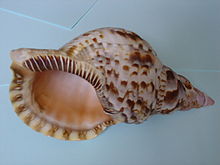- Triton (gastropod)
-
Triton 
Charonia variegata Scientific classification Kingdom: Animalia Phylum: Mollusca Class: Gastropoda (unranked): clade Caenogastropoda
clade Hypsogastropoda
clade LittorinimorphaSuperfamily: Tonnoidea Family: Ranellidae Subfamily: Cymatiinae Genus: Charonia
Gistel, 1847Type species Charonia variegata Lamarck, 1816 Species See text
Triton is the common name given to a number of very large sea snails, predatory marine gastropods in the genus Charonia. [1]
The name "triton" is also often applied as part of the common name, to other, much smaller sea snails of other genera within the same family, Ranellidae.
Tritons are named after the Greek god Triton, who was the son of Poseidon, god of the sea.
The shell of the giant triton Charonia tritonis (Linnaeus, 1758), which lives in the Indo-Pacific faunal zone, can grow to over half a metre (20 inches) in length.
One slightly smaller but still very large species, Charonia variegata (Lamarck, 1816), lives in the western Atlantic, from North Carolina to Brazil.
Contents
Distribution
Tritons inhabit temperate and tropical waters worldwide.
Life habits
Unlike pulmonate and opistobranch gastropods, tritons are not hermaphrodites; they have separate sexes and undergo sexual reproduction with internal fertilization. The female deposits white capsules in clusters, each of which contains many developing larvae. The larvae emerge free-swimming and enter the plankton, where they drift in open water for up to three months.
Feeding behavior
Adult tritons are active predators and feed on other molluscs and starfish. The giant triton has gained fame for its ability to capture and eat crown-of-thorns starfish, a large species (up to one metre in diameter) covered in poisonous spikes an inch long. This starfish has few other natural predators and has earned the enmity of humans in recent decades by proliferating and destroying large sections of coral reef.
Tritons can be observed to turn and give chase when the scent of prey is detected. Some sea stars (including the crown-of-thorns starfish) appear to be able to detect the approach of the mollusk by means which are not clearly understood, and they will attempt flight before any physical contact has taken place. Tritons, however, are faster than sea stars and only larger starfish have a reasonable hope of escape, and then only by abandoning whichever limb the snail seizes first.
The triton grips its prey with its muscular foot and uses its toothy radula (a serrated, scraping organ found in gastropods) to saw through the sea star's armoured skin. Once it has penetrated, a paralyzing saliva subdues the prey and the snail feeds at leisure, often beginning with the softest parts such as the gonads and gut.
Tritons will ingest smaller prey animals whole without troubling to paralyse them, and will spit out any poisonous spines, shells or other unwanted parts later.
Human use
Many people find triton shells attractive as a design object, and so they are collected and sold as part of the international shell trade. In recent years this has contributed to the animals' scarcity.
From ancient times, people of many different cultures have removed the tip of the shell, or drilled a hole in the tip, and then used the shell as a trumpet.
The Greco-Roman god Poseidon / Neptune is often depicted holding a triton shell, as is his son Triton (mythology).
Species and subspecies
Species and subspecies within the genus Charonia include:
- Charonia lampas (Linnaeus, 1758)
- Charonia lampas capax Finlay, 1927
- Charonia lampas lampas
- Charonia lampas pustulata Eurthyme, 1889
- Charonia lampas rubicunda (Perry, 1811)
- Charonia lampas sauliae (Reeve, 1844)
- Charonia tritonis (Linnaeus, 1758)
- Charonia variegata (Lamarck, 1816) - Caribbean Triton's trumpet
- Synonymized species
- Charonia eucla Hedley, 1914 : synonym of Charonia lampas (Linnaeus, 1758)
- Charonia eucla instructa Iredale, 1929
- Charonia nodifera : synonym of Charonia lampas (Linnaeus, 1758)
- Charonia powelli Cotton, 1957 : synonym of Charonia lampas (Linnaeus, 1758)
- 'Charonia seguenziae : synonym of Charonia variegata (Lamarck, 1816)
- Synonyms for Charonia
- Buccinatorium Mørch, 1877
- Eutritonium Cossmann, 1904
- Nyctilochus Dall, 1912
- Semiranella de Gregorio, 1880
- Septa Dall & Simpson, 1901
- Triton Montfort, 1810 (Invalid: junior homonym of Triton Linnaeus, 1758 [Amphibia])
- Tritonellium Mørch, 1877
- Tritonium Röding, 1798
References
- ^ Bouchet, P.; Gofas, S. (2010). Charonia Gistl, 1847. In: Bouchet, P.; Gofas, S.; Rosenberg, G. (2010) World Marine Mollusca database. Accessed through: World Register of Marine Species at http://www.marinespecies.org/aphia.php?p=taxdetails&id=138425 on 2010-10-31
- Beu A.G. 1998. Indo-West Pacific Ranellidae, Bursidae and Personidae (Mollusca: Gastropoda). A monograph of the New Caledonian fauna and revisions of related taxa. Mémoires du Muséum national d'Histoire naturelle 178: 1-255
External links
- An article on the crown-of-thorns starfish which contains excellent pictures of one being eaten by a triton.
- http://www.gastropods.com/5/Shell_395.shtml
Categories: - Charonia lampas (Linnaeus, 1758)
Wikimedia Foundation. 2010.


